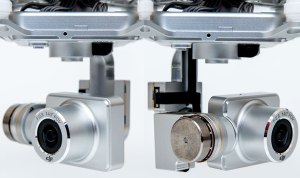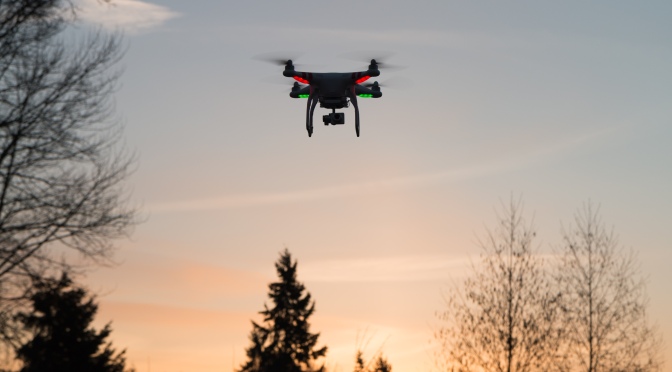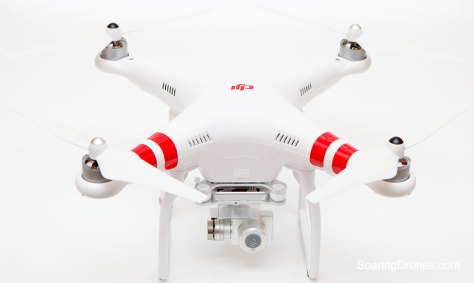Quick Summary
The DJI Phantom 2 Vision+ is currently the best option for a fully assembled, ready-to-fly drone or quadcopter with a camera. Whether you need buttery smooth video footage or still photos from the air, the Vision+ will be the least setup time, most beginner-friendly, and can be less expensive than assembling a custom solution to do the same job. Continue reading below to find out what we liked, what needs improvement, and how this new version measures up to similar quadcopters from DJI.
Highlighted Features of the Vision+
- The standout feature of the Vision+ is the 3-axis gimbal with the 1080p video camera (14 MP still photos) built right in. DJI makes high-end gimbals and ventured into cameras late last year with the original Phantom 2 Vision, but that model had a single-axis gimbal with plastic construction. Now just over 6 months later comes the Vision+ with same camera specs and an all-metal design that integrates both the camera and the gimbal into a sleek, lightweight alloy. Finally, this new gimbal lets the camera look straight down, giving you a point of view that wasn’t possible with the original Vision.
- Flight time of the Vision+ is about 25 minutes with the included intelligent battery. First introduced with the Phantom 2 Vision, this is the same 5,200-mAh battery used for all the Phantom 2 models and is light years ahead of the small battery (connected by a difficult-to-attach wire) included with the original Phantom series.
- DJI’s Vision App, for Android and iPhone, is the final aspect that separates the Vision+ from the do-it-yourself crowd and from the non-Vision copters in DJI’s lineup. First released with the Phantom 2 Vision, the latest version of the app adds support for the Vision+ gimbal, but it’s mostly the same app already used on the original Vision. We liked the radar positioning feature that shows the Vision+ in relation to your location. Another recent “feature” is the no-fly zones that force you to keep you clear of FAA restricted areas such as A zones (major airports or sensitive areas such as Tiananmen Square in Beijing) and B zones (smaller airports). This aspect is welcome insofar as it prevents the governing bodies from proscribing more heavy-handed restrictions in the future.
- Wi-Fi extended with a new maximum speed of 15 meters per second, or 33.5 mph and new maximum Wi-Fi range of 700m, 0.4 miles. DJI specifically highlights the ability of the Vision+ to video high-speed sports such as motocross, and we don’t doubt them. However, at top speed you’ll quickly lose visual contact and smash through that (newly extended) Wi-Fi range, so be careful.
Features In-Depth
What’s in the Box (and Not Included!)
DJI raised the bar on their packaging with this model. Gone are the random little bags stuffed into every corner. The propellers, charger, parts and instructions are elegantly separated in white cardboard sleeves that give the entire presentation an “Apple-esque” feel. Here’s what you get when you open all these glossy little white boxes:
- The Phantom 2 Vision+ main body with camera and gimbal already attached (including a handle gimbal-locking insert and camera lens cap that you should definitely save) and battery installed. DJI also thoughtfully includes a 4GB microSD card to provide a complete out-of-box experience.
- The controller/transmitter with smartphone holder and Wi-Fi extender already attached.
- The battery charger and an assortment of international plug adapters.
- Eight total propellers, a full set of four and four extras, for the inevitable run-in with Charlie Brown’s kite-eating tree (evolved to trap 21st-century “toys”)
- A compact little box of screws and tiny spare parts like extra feet for the landing skids.
- Finally, for the first time, DJI remembered to include four AA batteries for the controller. It seems obvious that someone paying more than a grand should be entitled to a few free alkalines, and DJI paid attention to this obvious customer pain point.
So What’s Missing? Here’s what you’ll want to immediately go out and buy or wish you had:
- Spare batteries so you can have extras charging while you’re flying. A battery takes several hours to fully charge, so even with the double-long flight time of the Phantom 2 vs. the original series you’ll need to get a backup or two. This is especially important so that you’re not tempted to run the battery too low while flying to get that “one last shot.”
- A sun shade for your mobile phone; flying in bright sunlight makes it really tough to see the first-person view (FPV) image on your phone’s washed-out screen.
- Some kind of case to hold it all! There are monster huge waterproof plastic boxes that hold the original Phantom and Phantom 2 variants, so I suspect there will be a custom version for the Vision+ in a few short weeks
What’s a Gimbal (and Why Do I Need One)?
You probably first encountered something gimbal-like at the toy store with one of those novelty gryoscopes, but the basic gimbal design is ancient, dating back to at least 200 BC. The concept is simple: you have some “thing” in the center you want to keep steady, so you surround it by a series of tilting rings that in turn move around each both other and the thing in the center, keeping the thing steady as your craft bounces on the wind or waves. Mariners used them to keep compasses and lanterns from tipping over. Fast-forward to the third millennium and we’ve chopped out un-necessary segments of the rings and attached high-speed servos controlled by sophisticated GPS-linked computers. The “thing ” is your HD video camera and your “craft” is now a polymer quadcopter capable of travelling at 33 miles per hour.
The Gimbal to Combat Motion (sickness)
Watching a video from a multi-rotor drone without a gimbal makes me queasy. Every time the copter moves the camera tilts and the resulting footage is jerky, wobbly and, if not quite vomit-inducing, it comes pretty close. The gimbal fixes this problem by keeping the camera steady even as the Phantom moves. In the original Vision (not +), the motion compensation barely qualified for the term “gimbal” and only corrected for forward/reverse copter movements by changing the camera tilt/pitch to keep a constant position (with respect to the ground) even as the Phantom tilted forward to generate thrust. The absolute tilt can also be manually set on the DJI Vision app so that the camera’s position could be fixed to a new angle, which it would then maintain during tilts of the rotors.
The 1-D “gimbal” wasn’t much, but it was enough to allow smooth acceleration and deceleration and helped make the Phantom 2 Vision extremely popular. Compared with the original Phantom and its fixed GoPro mount, the Vision was a big step forward. The original Vision also added stiff vibration-absorbing rubberized mounts that isolated the camera from the “jello” (small amounts of random shake evident in the video) you can see in the fixed, non-isolated mount of the Phantom 1.
Types of Gimbals: How Many Ds?
That simple 1-D gimbal in the Phantom 2 Vision adjusted for one axis of motion and couldn’t correct for side to side (roll) or turning (yaw) motion. The Phantom 2 (non-Vision) and Phantom 1 have the option of a 2-D gimbal for GoPro (Zenmuse H3-2D) that corrects both the pitch and roll motions but still couldn’t keep the camera oriented at a fixed location when turning the Phantom about the z-axis (yaw). Enter the 3-D gimbal of the Vision+ and we get correction for all three directions, pitch, roll and yaw. But wait? If the Phantom is turning (yaw) and the camera stays fixed to the horizon, what happens? You get a nice fat picture of the landing skids in the way! That’s right, since the Phantom 1/2 series has fixed landing gear, the axis on the Vision+ is really “2.5-D” and allows you smooth out the turns, but eventually the camera has to follow along. The full range of the yaw compensation is about 45-degrees to each side (see photo), so you can start panning the camera by turning the entire Phantom and the camera will absorb your initial jerky turn and will smoothly capture the scene as you pan across a scenic landscape below.
oriented at a fixed location when turning the Phantom about the z-axis (yaw). Enter the 3-D gimbal of the Vision+ and we get correction for all three directions, pitch, roll and yaw. But wait? If the Phantom is turning (yaw) and the camera stays fixed to the horizon, what happens? You get a nice fat picture of the landing skids in the way! That’s right, since the Phantom 1/2 series has fixed landing gear, the axis on the Vision+ is really “2.5-D” and allows you smooth out the turns, but eventually the camera has to follow along. The full range of the yaw compensation is about 45-degrees to each side (see photo), so you can start panning the camera by turning the entire Phantom and the camera will absorb your initial jerky turn and will smoothly capture the scene as you pan across a scenic landscape below.
Camera Specs and Performance
The camera’s housing has changed to all-metal and integrates nicely with the gimbal, but the basic specs haven’t changed since the original Phantom 2 Vision. The sensor is capable of 1080p HD video at 30 fps (30p) or 60 interlaced frames per second (60i) and outputs 14MP stills in either sensor RAW (which programs like Adobe Lightroom 5 support for enhanced dynamic range and white balance tweaking) or the more standard JPEG format. Adobe’s also providing lens correction profiles (especially helpful for barrel distortion) in their newest raw processing engine in Photoshop’s ACR and Lightroom.
Back to the hardware, the lens also seems identical with an f/2.8 maximum aperture and a 140-degree field of view. The video can be cropped to still get 1080p footage from the center of the frame, yielding more natural looking videos without the extreme wide-angle look of the 140-degree lens. All in all the video from this camera has a slight edge over the GoPro Hero3+, and I’ll be posting some follow-up stills and comparison tests. Meanwhile, enjoy the video below, just a few minutes long.
But how does it fly?
With a camera and gimbal attached, you’d be forgiven for thinking that the Vision+ is less nimble than the unencumbered Phantom 1. We did see a difference in flying, and we think it’s because (not yet verified) that the software settings for how quickly the copter responds have been toned down a bit. It’s much easier to fly the Vision+ smoothly, and we found it easier to keep the camera steady even if you factor out the gimbal. The Vision+ seems destined for a life of grand panoramic bliss as it glides across your favorite landscape or event.
All the standard Phantom series features are present including the emergency automatic landing at your home point, intelligent orientation control and GPS/manual stability control.
Conclusion
With the price drop on the original Vision to $999 and the introduction of this new model, you’ve now got a quandary: spend what you would have spent last week on the Vision to get this new, improved model, or save $300 and go for the older (6 months, mind you!) model with only a single axis. For us, the question comes down to a simple choice–if you’re looking to make serious movies that people will actually want to see, go for the Vision+. The extra stability from the gimbal and the elegant camera design are worth every cent and the whole system is now so tightly integrated that this new model has become more than just a “Vision with a gimbal”. It’s a whole new generation.
If you merely want to experiment with first-person video and like playing with the latest toy, consider the Phantom FC40, also from DJI, or the even cheaper Parrott AR 2.0 drone that uses your smartphone to view and control the craft in flight. Both of these will satisfy your novelty itch and cost less than half as much as the Vision+. But those the budding film-maker or someone who uses a quadcopter for their job (farmer, realtor, emergency response, government), the Vision+ is the real deal. You take it out, screw on the props, charge the batteries and fly and still get home in time for dinner.
Let it soar!
Support our site by purchasing at Amazon:
Vision+: DJI Phantom 2 Vision+ Quadcopter with FPV HD Video Camera and 3-Axis Gimbal
Original Vision: DJI Phantom 2 Vision+ Quadcopter with FPV HD Video Camera and 3-Axis Gimbal
Spare battery for either: DJI Battery for Phantom 2 and Phantom 2 Vision (White)

